Home > Stroke
Stroke
Stroke rehabilitation helps restore movement, strength, and independence through specialized therapy
A stroke is a medical emergency caused by an interruption of blood flow to the brain, leading to cell damage or death. It occurs due to either a blocked blood vessel (ischemic stroke) or a ruptured vessel (hemorrhagic stroke). Strokes can also result from transient blood flow disruptions, known as transient ischemic attacks (TIAs), often called “mini-strokes.” Symptoms include sudden weakness or numbness, especially on one side of the body, difficulty speaking or understanding speech, vision problems, severe headache, dizziness, or loss of balance. Recognizing these signs early is crucial, summarized by the acronym FAST: Facial drooping, Arm weakness, Speech difficulties, Time to call emergency services. Risk factors include hypertension, diabetes, smoking, obesity, high cholesterol, and atrial fibrillation. Preventive measures involve maintaining a healthy lifestyle, controlling blood pressure, avoiding smoking, and managing underlying health conditions. Prompt treatment is essential. For ischemic strokes, clot-busting medications like tPA or mechanical thrombectomy can restore blood flow. Hemorrhagic strokes may require surgical intervention. Post-stroke rehabilitation focuses on physical, occupational, and speech therapy to regain lost functions and improve quality of life.


© Copyright 2024. Dr. Murtuza Rangwala. All Rights Reserved.

